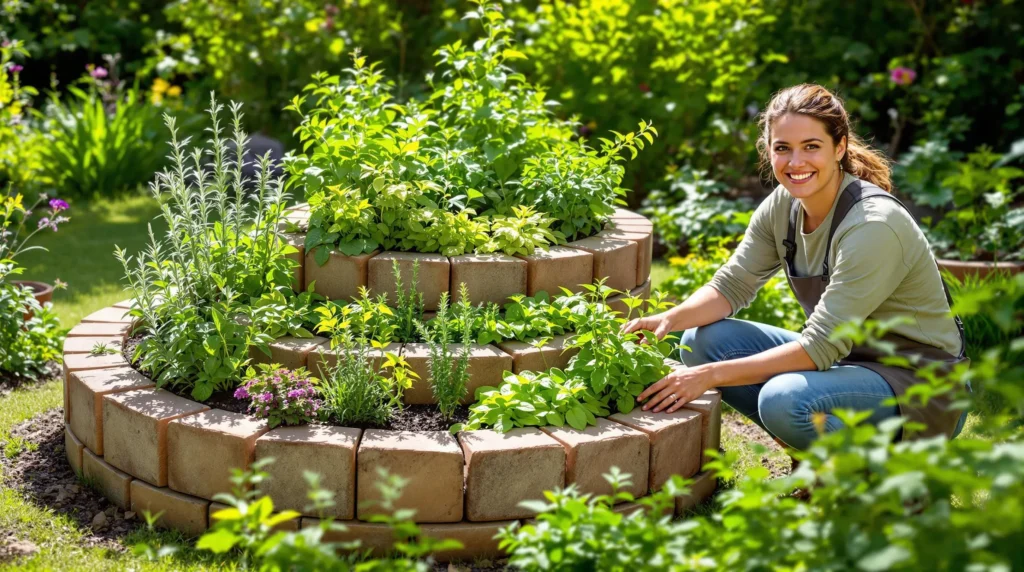What Is an Herb Spiral Garden and Why Build One?
An herb spiral garden is a three-dimensional, vertically-designed growing space that rises from the ground in a spiral shape. This permaculture design technique maximizes growing area in minimal space while creating multiple microclimates in a single structure. The spiral typically stands 3-5 feet tall and 5-7 feet in diameter, allowing you to grow up to 20-30 different herbs in an area that would normally accommodate just a few plants. Sun exposure varies around the spiral, with the south-facing side receiving more sunlight and the north side offering shade, creating perfect conditions for herbs with different light requirements. Water efficiency is another key benefit, as moisture naturally flows from top to bottom, creating dry zones at the top and more humid conditions at the base. Beyond its practical advantages, an herb spiral serves as a stunning focal point in your garden while promoting biodiversity and sustainable growing practices. You’ll find it’s not only a space-saving solution but also an accessible way to harvest fresh herbs without excessive bending or kneeling.
7 Essential Steps to Design Your Perfect Herb Spiral
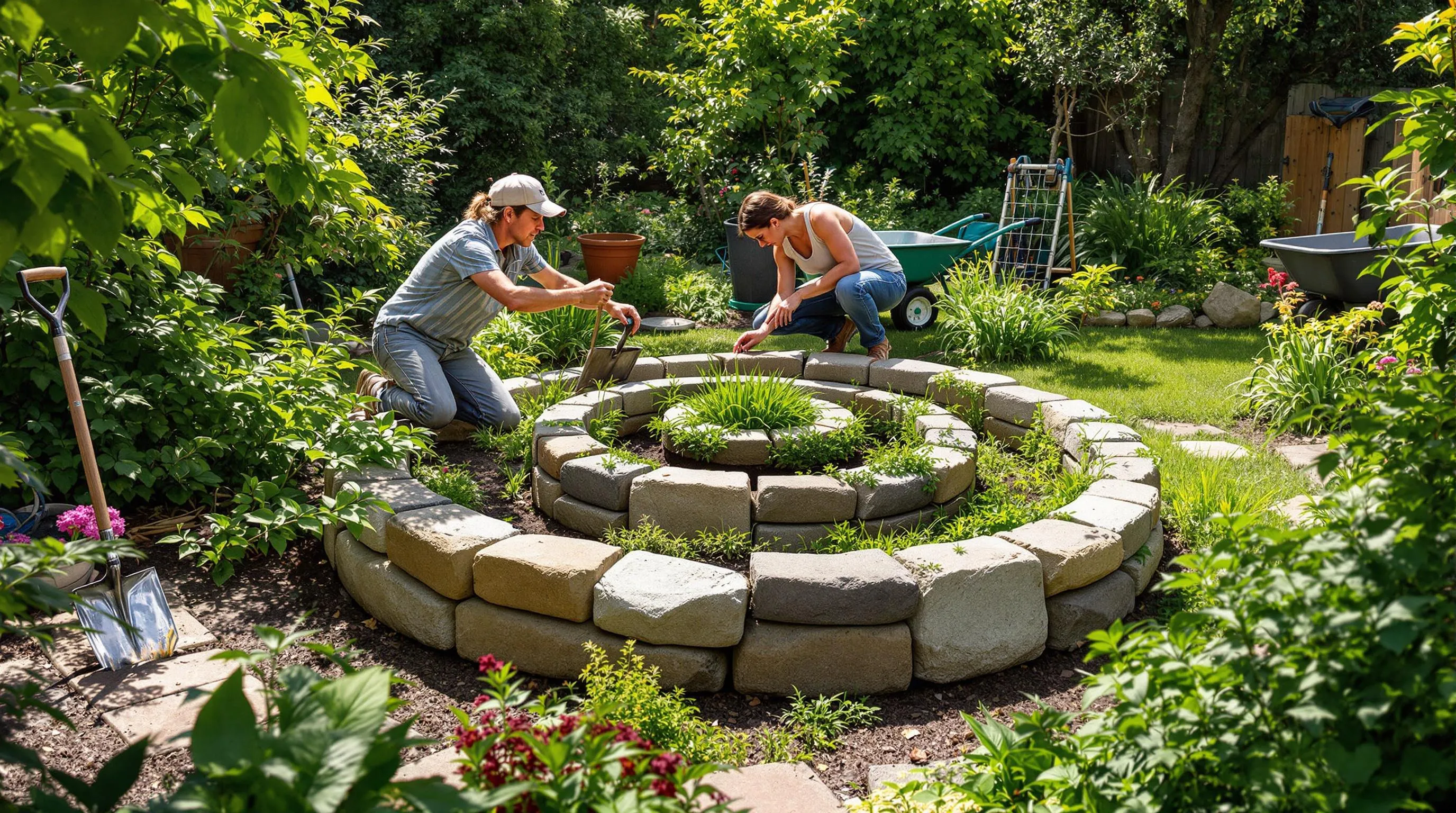
Creating your own herb spiral doesn’t have to be complicated. Follow these seven essential steps to design a functional and beautiful herb spiral that will enhance your garden space while providing fresh herbs right at your fingertips.
Choosing the Ideal Location
Select a spot that receives at least 6-8 hours of sunlight daily for optimal herb growth. The south-facing side of your yard is typically ideal as it maximizes sun exposure throughout the day. Ensure your chosen location is easily accessible from your kitchen to make harvesting convenient. Avoid low-lying areas that collect water, as most herbs prefer well-drained soil. Consider proximity to trees whose roots might compete with your herbs or create too much shade. The perfect location balances visibility (as your spiral will become a focal point) with functionality, allowing you to enjoy both its beauty and bounty.
Gathering Materials and Tools
Collect approximately 2-3 cubic yards of stones or bricks for a standard-sized spiral (5-6 feet in diameter). You’ll need a wheelbarrow, garden shovel, level, measuring tape, garden hose or rope, and garden gloves as essential tools. For soil, prepare a mixture of topsoil, compost, and sand to ensure proper drainage. Consider adding exact soil amendments based on the herbs you plan to grow—Mediterranean herbs like thyme and rosemary prefer sandier soil, while moisture-loving herbs like mint benefit from more organic matter. Don’t forget to gather cardboard or industry fabric for the base layer to prevent weed growth, and have a watering can or irrigation system planned for maintenance.
Creating the Foundation
Start by marking your spiral’s outline using a garden hose or rope, typically 5-7 feet in diameter. Remove any grass or weeds from the area and lay down cardboard or industry fabric as a weed barrier. Begin building from the center, placing your largest, sturdiest stones first to establish the core structure. Work outward in a spiral pattern, gradually decreasing the height as you go. The walls should slope downward from approximately 3 feet at the center to ground level at the outer edge. Ensure each stone is stable and level before adding the next one. Fill the structure with your soil mixture as you build, creating distinct planting zones at different heights. The completed foundation should have a solid, stable appearance with clear pathways for accessing all areas of the spiral.
10 Creative Herb Spiral Garden Ideas for Small Spaces
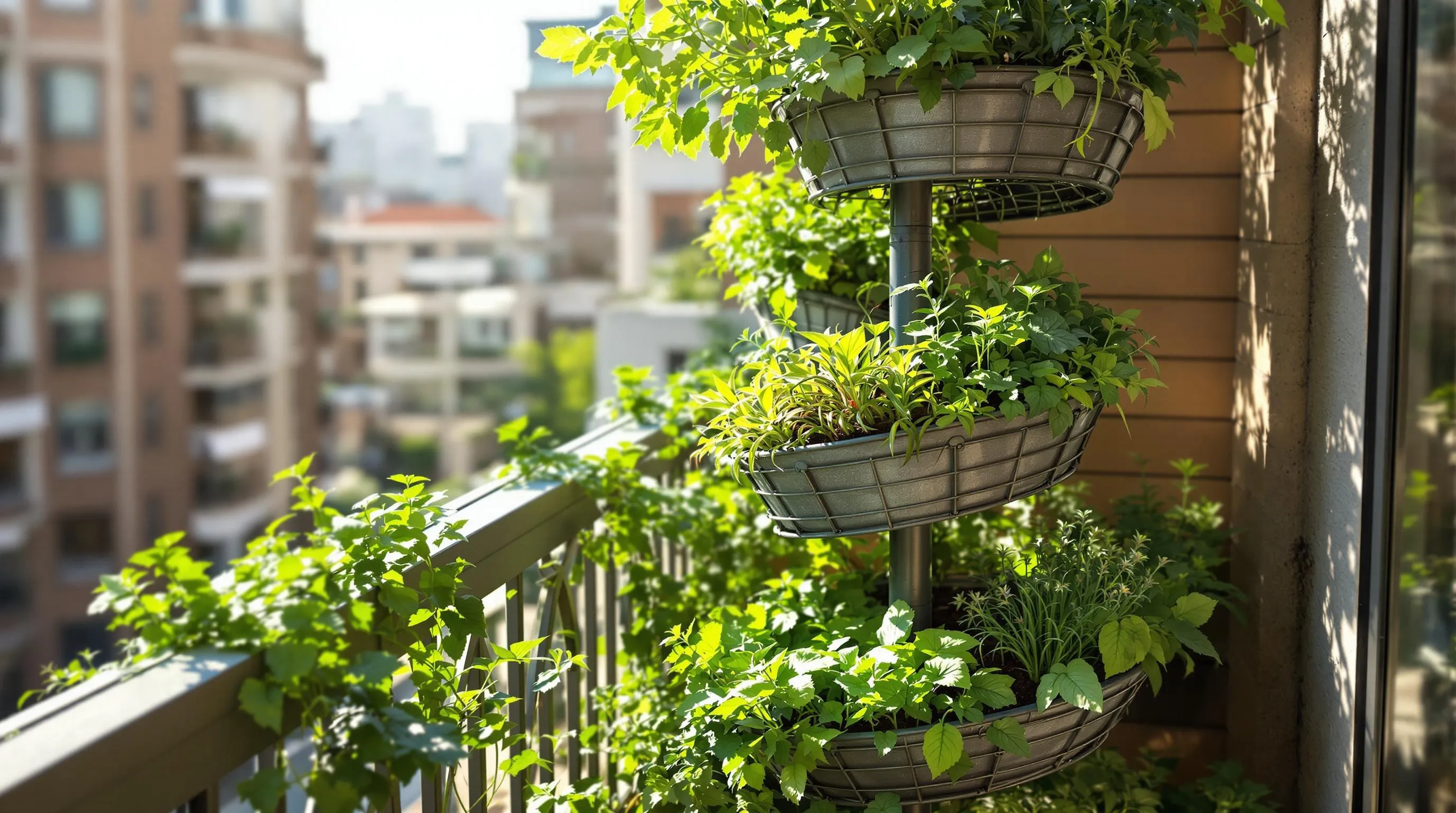
Looking to maximize your herb growing potential in limited space? These innovative herb spiral adaptations offer unique answers for small gardens, balconies, and urban settings while maintaining the permaculture benefits of traditional spirals.
1. Urban Balcony Herb Spirals
Transform your balcony into a productive herb garden with a compact spiral design. Use lightweight materials like recycled plastic containers or fabric pots arranged in a spiral formation around a central post. Secure the structure to your balcony railing for stability and choose drought-resistant herbs like rosemary, thyme, and sage for the top levels, with moisture-loving mint and parsley at the bottom. This space-saving design typically fits in a 3-foot diameter area while still growing 10-15 different herbs.
2. Vertical Wall-Mounted Spirals
Use vertical space by creating a wall-mounted herb spiral. Install a spiral-shaped trellis or metal frame on an exterior wall that receives adequate sunlight. Attach small containers, pocket planters, or modified gutters to follow the spiral pattern. This innovative approach works brilliantly for apartments and townhouses with limited ground space but available wall areas. For optimal growth, position sun-lovers like oregano and basil at the top of the spiral where they’ll receive maximum light.
3. Container-Based Mini Spirals
Create a portable herb spiral using nested containers of decreasing sizes. Start with a large base container (24-30 inches wide) and stack progressively smaller pots in a spiral pattern, using bricks or stones between layers for stability. This adaptable design can be placed on patios, decks, or even indoor spaces with sufficient light. The entire system can be disassembled and moved seasonally to optimize growing conditions, making it perfect for renters or those with changing garden spaces.
4. Repurposed Tire Spirals
Create an eco-friendly herb spiral using old tires stacked in decreasing sizes. Paint the tires with non-toxic outdoor paint to enhance aesthetics and protect from degradation. Fill each tire with quality potting soil mixed with compost, and plant herbs according to their sunlight and moisture needs. This sustainable approach repurposes waste materials while providing distinct planting zones for different herb varieties, all within a footprint of about 4 feet in diameter.
5. Spiral Herb Towers
Build upward with a tower design that spirals herbs around a central support. Use a tall cylindrical wire cage filled with soil in the center, then wrap a spiral path of growing pockets around it using industry fabric or repurposed plastic bottles. This vertical design can accommodate 20+ herb varieties in just a 2-foot diameter footprint, making it ideal for apartment dwellers with only a small outdoor corner available for gardening.
6. Indoor Window Spiral Shelves
Design a spiral-shaped shelving unit that fits in front of a sunny window. Each shelf level follows a spiral pattern and provides different light exposures as the sun moves throughout the day. Use shallow containers with proper drainage on each level, growing shade-tolerant herbs like mint and cilantro on lower shelves while placing basil and rosemary on upper levels. This innovative indoor adaptation brings the herb spiral concept inside, providing fresh herbs year-round regardless of outdoor space limitations.
7. Tabletop Herb Spirals
Create miniature herb spirals using wide, shallow bowls or trays as the base. Build tiny spirals using small stones or miniature bricks, rising just 6-8 inches in height but still providing the microclimate benefits of full-sized versions. These charming tabletop gardens can grow 5-7 different compact herb varieties and serve as functional centerpieces on outdoor dining tables or sunny kitchen counters, putting fresh herbs within immediate reach during meal preparation.
8. Floating Aquaponic Spirals
Combine herb growing with small-scale aquaponics by creating a water-based spiral. Use floating platforms arranged in a spiral pattern in a small pond or large container of water. The plants draw nutrients directly from the water, which can be populated with small fish like guppies that provide natural fertilization. This innovative system creates a self-sustaining mini network while growing water-loving herbs like mint, watercress, and Vietnamese coriander in spaces as small as a 3-foot diameter container.
9. Modular Magnetic Spirals
Design a customizable herb spiral using magnetic planters that attach to a metal backing board or refrigerator. Arrange small magnetic containers in a spiral pattern, allowing for easy rearrangement as plants grow or seasons change. This ultra-space-saving approach works well in urban kitchens with limited countertop space, providing fresh herbs right where you cook while taking up zero floor space.
10. Spiral Herb Gardens in Furniture
Incorporate herb spirals into functional furniture pieces like hollow ottomans, coffee tables, or bench seating with built-in planters. The spiral design is created within the furniture structure, with varying depths for different herbs. These dual-purpose items maximize space efficiency by combining seating or table surfaces with productive herb growing areas, perfect for tiny apartments, rooftop gardens, or small patios where every square foot must serve multiple functions.
8 Beautiful Stone Arrangements for Your Herb Spiral
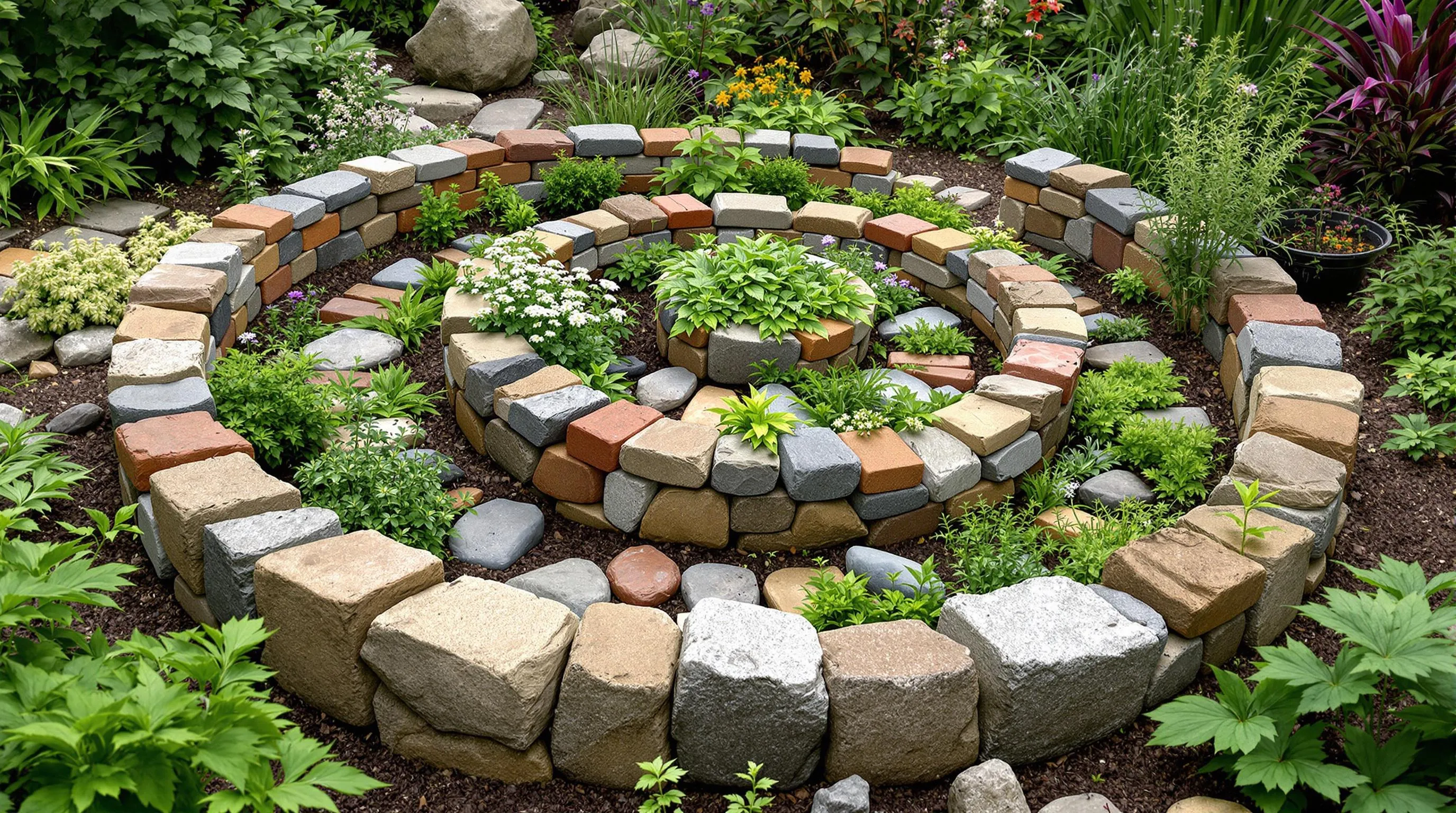
Natural Fieldstone Designs
Natural fieldstone creates a rustic, organic look that blends seamlessly with your garden industry. Choose stones of varying sizes—larger at the bottom, smaller toward the top—to establish a stable structure with natural character. Stack the irregularly shaped fieldstones in a dry-wall technique, slightly angling them inward for better stability. The natural coloration and texture of fieldstones complement herbs beautifully and weather gracefully over time, developing moss and lichen that enhance the natural aesthetic.
Brick Pattern Variations
Bricks offer versatility and precision for herb spiral construction with multiple pattern options. Try the classic running bond pattern for stability, or create visual interest with herringbone arrangements around curved sections. Soldier courses (bricks standing vertically) make excellent spiral edges, defining the tiers clearly. For a Mediterranean feel, combine red clay bricks with occasional blue or decorative ceramic tiles. Reclaimed bricks add character with their weathered appearance and sustainable appeal—their uniform shape makes construction more straightforward than irregular stones.
River Rock Creations
Smooth river rocks create a calming, water-inspired herb spiral perfect for cottage or Japanese-style gardens. Arrange larger, flatter stones at the base and smaller, rounder ones as you build upward. The polished surface of river rocks reflects light beautifully, making your herb spiral shimmer in sunshine. For enhanced visual appeal, incorporate stones of varying colors—from slate gray to warm amber. River rocks also retain heat effectively, creating beneficial thermal mass that moderates soil temperature for your herbs and extends your growing season.
12 Best Herbs to Plant in Your Spiral Garden
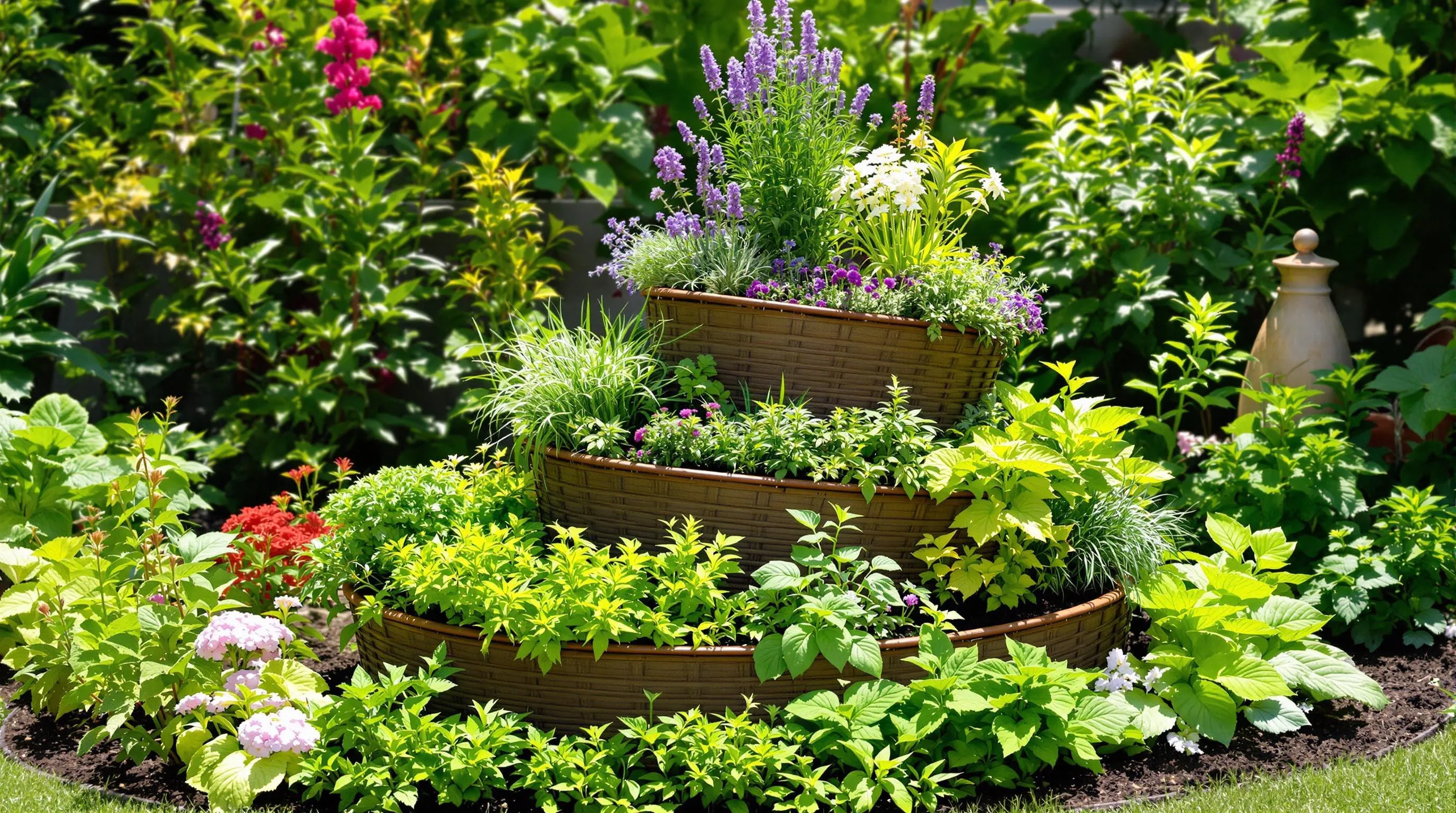
An herb spiral’s genius lies in creating distinct microclimates that accommodate various herbs with different growing requirements. Selecting the right herbs for each zone maximizes your spiral’s productivity and ensures thriving plants year-round. Here are the best herbs to plant based on their preferred growing conditions within your spiral garden.
Sun-Loving Herbs for the Top
The top section of your herb spiral receives the most sunlight and has excellent drainage, making it perfect for Mediterranean herbs that thrive in dry, sunny conditions. Rosemary stands as an excellent anchor plant with its woody structure and fragrant needles. Thyme varieties like English and lemon thyme create beautiful cascading effects while offering distinct flavors for culinary use. Sage, with its velvety leaves and purple-blue flowers, adds both culinary value and visual interest. Lavender thrives in this zone, providing stunning purple blooms and calming fragrance. Oregano, a hardy perennial, spreads nicely along the upper edges with minimal care once established. These sun-lovers require less watering and enjoy the well-drained soil at the spiral’s peak.
Moisture-Loving Herbs for the Bottom
The bottom section of your herb spiral retains more moisture and offers partial shade, creating ideal conditions for herbs that prefer cooler, damper environments. Mint varieties (peppermint, spearmint, chocolate mint) flourish here but plant them in buried containers to control their aggressive spreading. Lemon balm, with its citrusy fragrance, thrives in this zone while attracting beneficial pollinators. Chives and garlic chives add vertical interest with their slender leaves and edible flowers. Parsley, both flat-leaf and curly varieties, grows abundantly in this moisture-rich area, providing fresh garnishes year-round. These herbs appreciate the consistent moisture that naturally collects at the spiral’s base, creating a perfect microclimate for their exact needs.
Herbs for the Middle Zones
The middle sections of your herb spiral offer balanced growing conditions that suit a wide range of culinary and medicinal herbs. Basil varieties (sweet, Thai, purple) thrive in these transition zones with moderate moisture and partial sun exposure. Cilantro/coriander performs well here, providing both flavorful leaves and seeds for different culinary uses. Dill adds feathery texture and height while attracting beneficial insects like butterflies. Chamomile, with its daisy-like flowers, grows happily in the middle zones and makes delightful teas. Calendula offers edible flowers with bright orange petals that add visual appeal while serving medicinal purposes. These middle-zone herbs benefit from the spiral’s natural gradient of sun exposure and moisture, allowing you to place them precisely where they’ll thrive based on their exact preferences.
6 Ways to Enhance Your Herb Spiral with Companion Plants
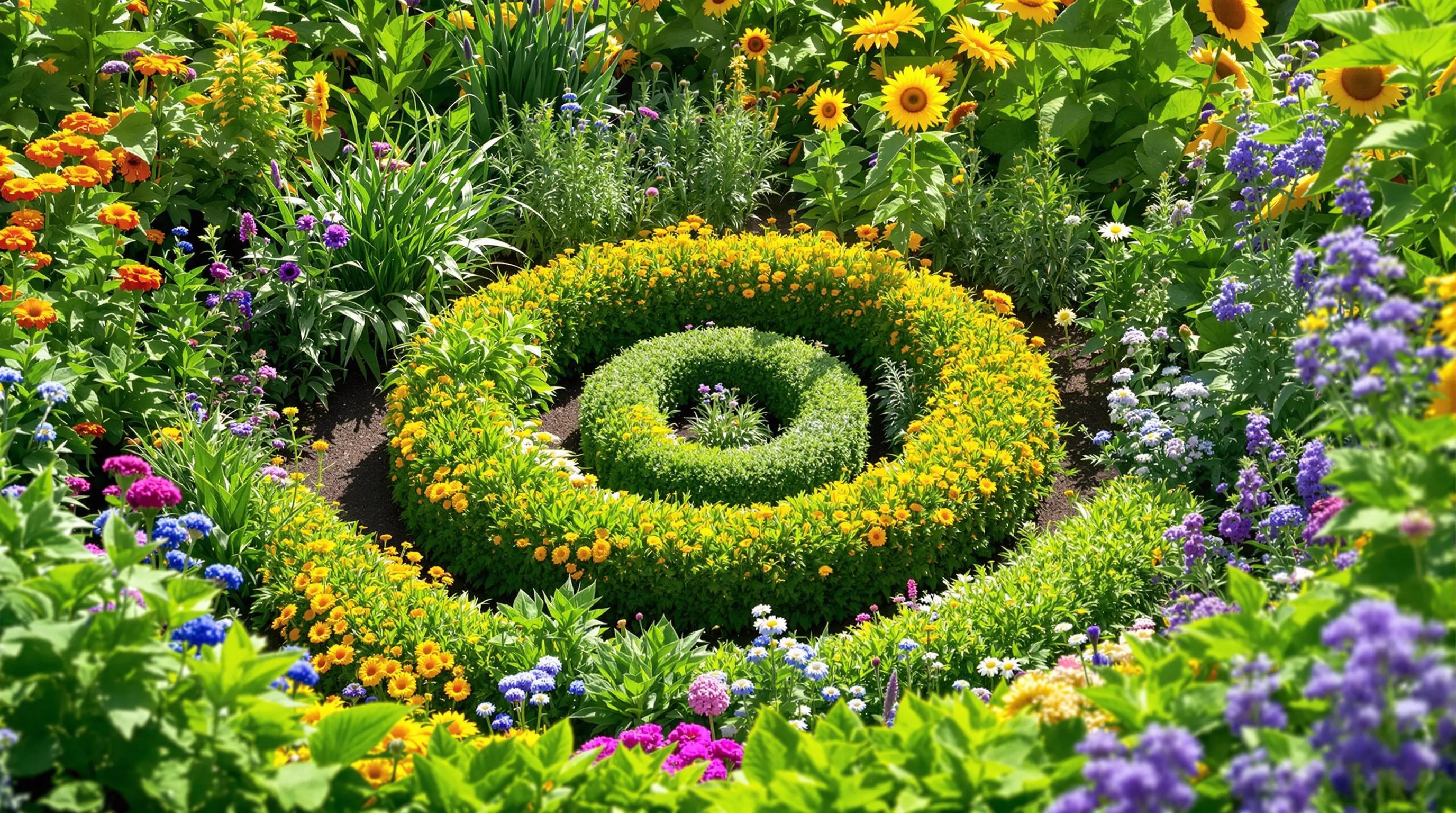
Companion planting in your herb spiral creates a thriving network that improves plant health, deters pests, and increases yields. These strategic plant partnerships can transform your spiral garden from merely functional to exceptionally productive.
1. Aromatic Pest Deterrents
Plant strong-scented companions like marigolds, nasturtiums, and alliums throughout your spiral to naturally repel harmful insects. Marigolds emit a scent that deters nematodes and aphids, while nasturtiums act as trap crops for aphids, protecting your valuable herbs. Position these aromatic defenders strategically at the edges of your spiral or interspersed between vulnerable herbs to create a protective barrier against unwanted pests.
2. Pollinator Attractors
Incorporate flowering plants such as borage, calendula, and echinacea to draw beneficial pollinators to your herb spiral. These flowering companions not only enhance the visual appeal of your garden but also increase pollination rates for herbs that produce seeds. Borage’s bright blue star-shaped flowers are irresistible to bees, while calendula blooms continuously through the growing season, ensuring a steady stream of helpful insects visiting your garden.
3. Nitrogen Fixers
Integrate nitrogen-fixing plants like clover, beans, or peas into your herb spiral to naturally fertilize neighboring herbs. These plants form symbiotic relationships with soil bacteria to convert atmospheric nitrogen into a form that plants can use. Place these beneficial companions in the middle to lower sections of your spiral where they can enrich the soil for nearby herbs without competing for resources, reducing your need for additional fertilizers.
4. Shade Providers
Use taller plants like sunflowers or Jerusalem artichokes on the north side of your spiral to create additional microclimates for shade-loving herbs. These towering companions cast beneficial shadows during hot summer months, protecting sensitive herbs from scorching sun. Position them strategically to avoid blocking sunlight from sun-loving herbs while creating perfect growing conditions for shade-preferring varieties like mint and lemon balm.
5. Beneficial Insect Habitats
Add umbelliferous plants such as dill, fennel, and Queen Anne’s lace to attract predatory insects that control pest populations. These plants feature umbrella-shaped flower clusters that serve as landing pads for beneficial insects like ladybugs, lacewings, and parasitic wasps. Distribute these habitat-creating companions throughout your spiral to establish natural pest control stations that maintain ecological balance without chemical interventions.
6. Root Structure Diversity
Combine plants with different root structures to maximize soil utilization and prevent competition. Shallow-rooted herbs like thyme and oregano work well alongside deeper-rooted companions such as comfrey or dandelion. The deep-rooted plants bring up nutrients from lower soil levels, making them available to their shallow-rooted neighbors. This underground partnership creates efficient use of soil resources and improves overall plant health throughout your spiral garden.
5 Sustainable Features to Add to Your Herb Spiral
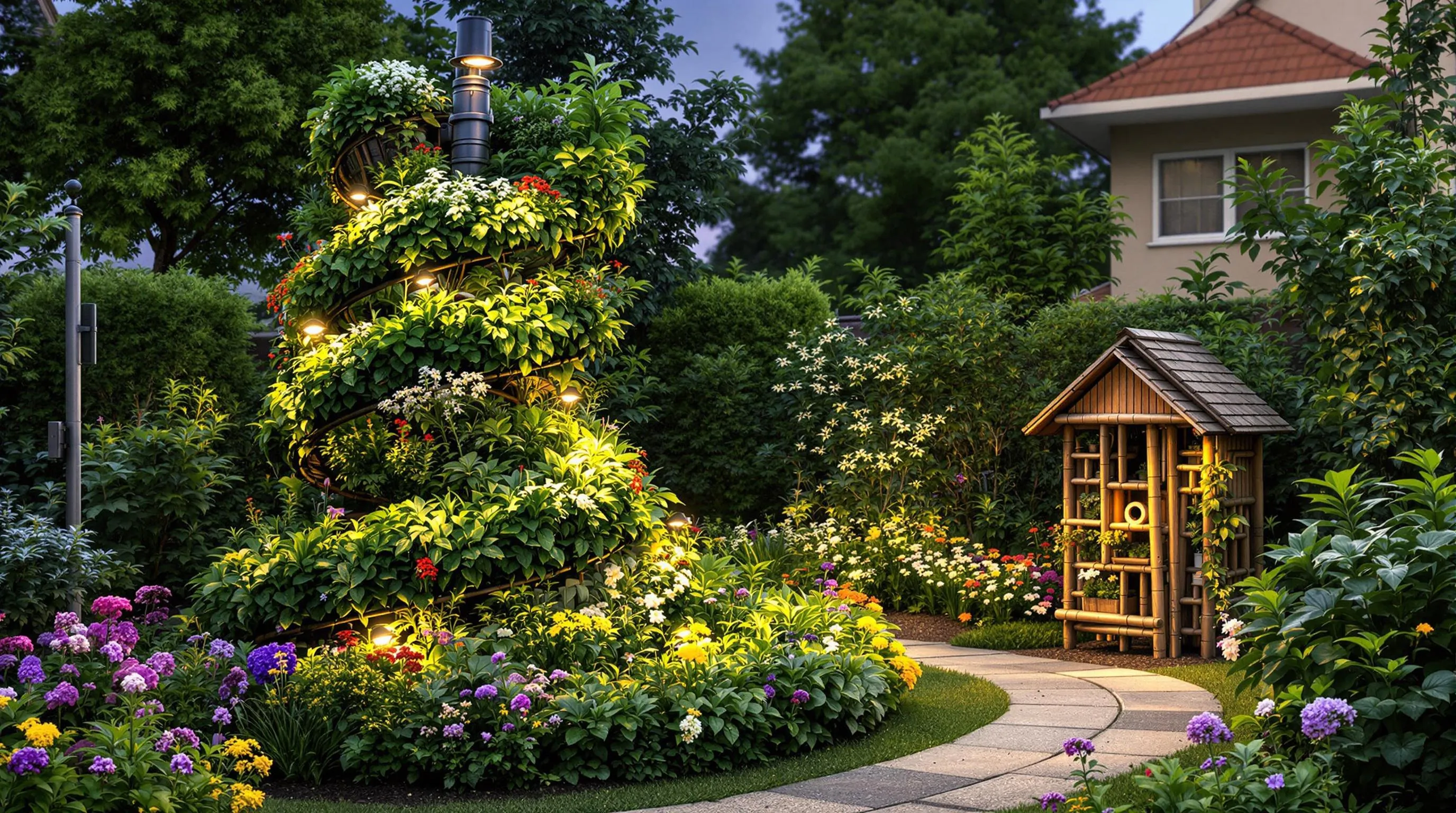
Transform your herb spiral into an eco-friendly powerhouse by incorporating these sustainable elements that enhance functionality while minimizing environmental impact.
Rainwater Collection Systems
Maximize water efficiency by installing a simple rainwater harvesting system for your herb spiral. Place a rain barrel at the downspout of your home’s gutter system, then connect it to a drip irrigation line that leads to the top of your spiral. This setup allows gravity to distribute water naturally throughout the spiral’s levels, mimicking natural rainfall patterns. For a more advanced system, incorporate a small solar-powered pump to automate watering during dry periods. Rainwater collection not only reduces your water bill but also provides chemical-free water that herbs prefer over treated tap water.
Compost Integration
Incorporate composting directly into your herb spiral design to create a self-sustaining growing system. Build a small compost chamber within the central core of your spiral using a perforated plastic tube or wire mesh cylinder. This central composting system breaks down kitchen scraps and garden waste, generating heat that can extend your growing season while providing continuous nutrients to your herbs. Alternatively, create a nested compost ring around the base of your spiral to capture fallen leaves and trimmings while feeding moisture-loving herbs. This closed-loop system reduces waste and eliminates the need for store-bought fertilizers.
Beneficial Insect Habitats
Create dedicated spaces for helpful garden allies by incorporating insect hotels into your herb spiral. Install small bundles of hollow bamboo stems, drilled wood blocks, or stacked stones with tiny gaps between the rocks on the south-facing side of your spiral. These microhabitats attract pollinators like solitary bees and predatory insects such as ladybugs and lacewings that help control pest populations naturally. Consider adding a shallow water dish with pebbles at the base of your spiral to provide drinking spots for butterflies and beneficial insects, creating a complete network that maintains itself with minimal intervention.
Native Plant Integration
Enhance biodiversity and resilience by incorporating native flowering plants among your culinary herbs. Select native species that match your region’s growing conditions and interplant them throughout your spiral. These native additions attract local pollinators specifically adapted to your network while requiring less water and maintenance than non-native alternatives. Position drought-tolerant natives near the top of the spiral and moisture-loving native species toward the bottom. This strategic integration creates a more balanced network that supports local wildlife while maintaining the primary function of your herb garden.
Solar-Powered Lighting
Extend the functionality and beauty of your herb spiral after sunset by incorporating solar-powered lighting. Install small solar path lights around the base of your spiral or weave solar-powered string lights through the structure to create a magical nighttime focal point. These lights not only enhance evening garden enjoyment but also serve practical purposes—illuminating herbs for nighttime harvesting and deterring certain nocturnal pests. Choose warm-colored LEDs rather than bright white lights to minimize disruption to beneficial insects and pollinators that navigate by moonlight. This sustainable lighting solution requires no electricity and automatically activates at dusk, highlighting your spiral’s beautiful architecture year-round.
9 Seasonal Maintenance Tips for a Thriving Herb Spiral
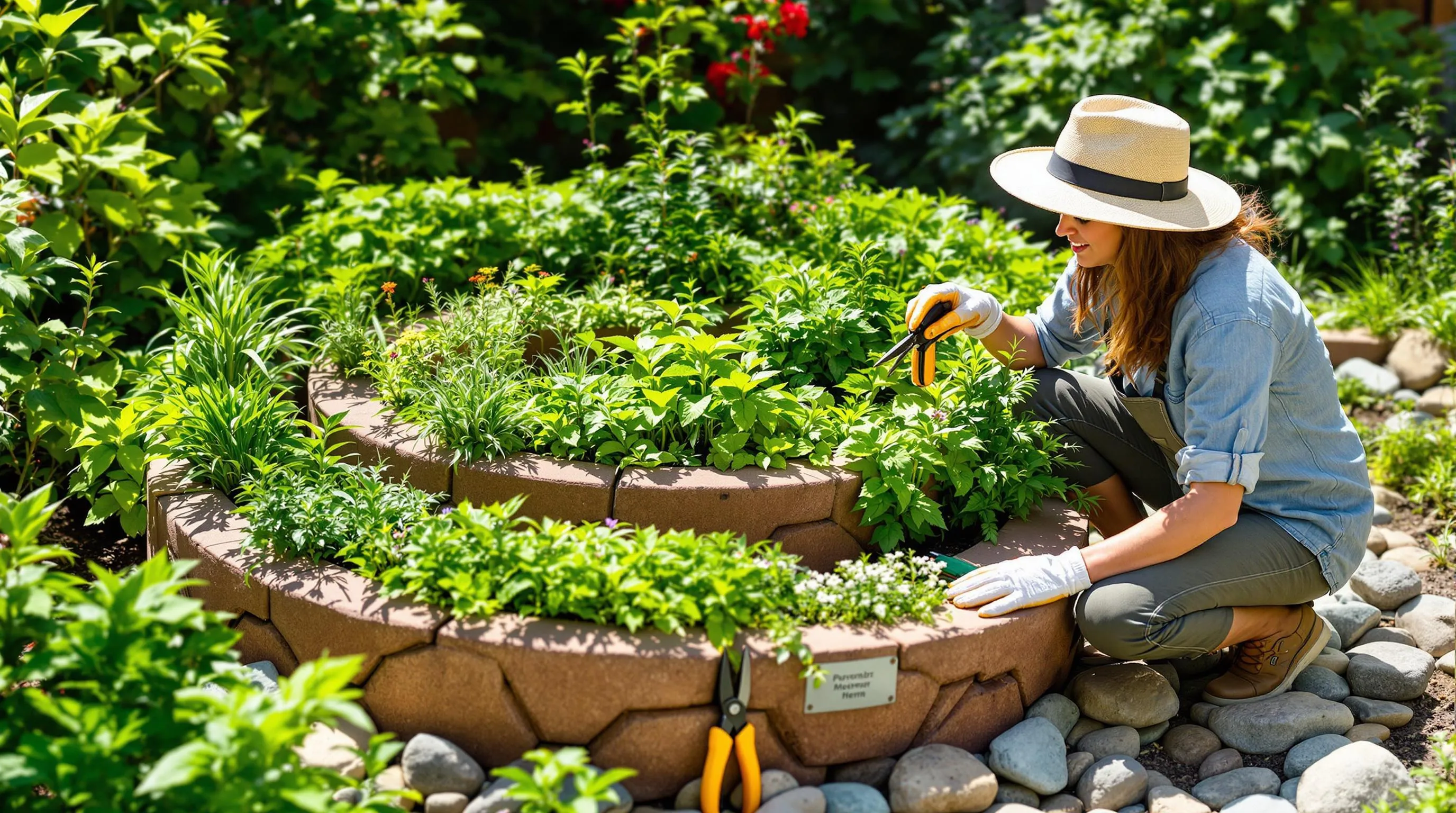
Spring Care Routines
Spring marks the perfect time to rejuvenate your herb spiral after winter dormancy. Start by clearing away dead plant material and pruning perennial herbs like rosemary and thyme back by one-third to encourage fresh growth. Add a 1-inch layer of compost to the entire spiral, working it gently into the soil without disturbing root systems. Check for and repair any winter damage to the structure, repositioning stones that may have shifted during freeze-thaw cycles. Early spring is also ideal for dividing overgrown perennial herbs such as chives and mint, replanting smaller sections to maintain vigor. Test soil pH and adjust if necessary, as most herbs prefer slightly alkaline conditions between 6.5 and 7.0.
Summer Harvesting Techniques
Summer calls for strategic harvesting to promote continuous herb production. Harvest herbs in the morning when essential oil content is highest, typically after dew has dried but before the midday heat. Pinch growing tips regularly, especially on basil and mint, to encourage bushier growth and prevent premature flowering. When harvesting leafy herbs like cilantro and parsley, take outer leaves first and leave the center intact for continued growth. For herbs grown primarily for flowers, such as lavender and chamomile, harvest just as blooms begin to open. Water deeply but infrequently during summer months, allowing the top inch of soil to dry between waterings while focusing moisture at the base of plants rather than on foliage.
Fall and Winter Protection
Prepare your herb spiral for cold weather by harvesting final crops and processing herbs for storage before the first frost. Cut back Mediterranean herbs like rosemary and sage lightly, but avoid severe pruning which makes plants vulnerable to winter damage. Apply a 2-inch layer of mulch around perennials, keeping it slightly away from stems to prevent rot. Consider covering cold-sensitive herbs with breathable fabric or installing a small portable greenhouse over sections of your spiral. In zones 7 and below, transplant tender perennials like rosemary into containers that can be brought indoors. Clean and store garden tools, and document this year’s successes and challenges to improve your strategy for next spring’s planting. For extreme climates, creating a simple windbreak on the north side of your spiral can significantly reduce winter stress on your herbs.
How to Troubleshoot Common Herb Spiral Problems
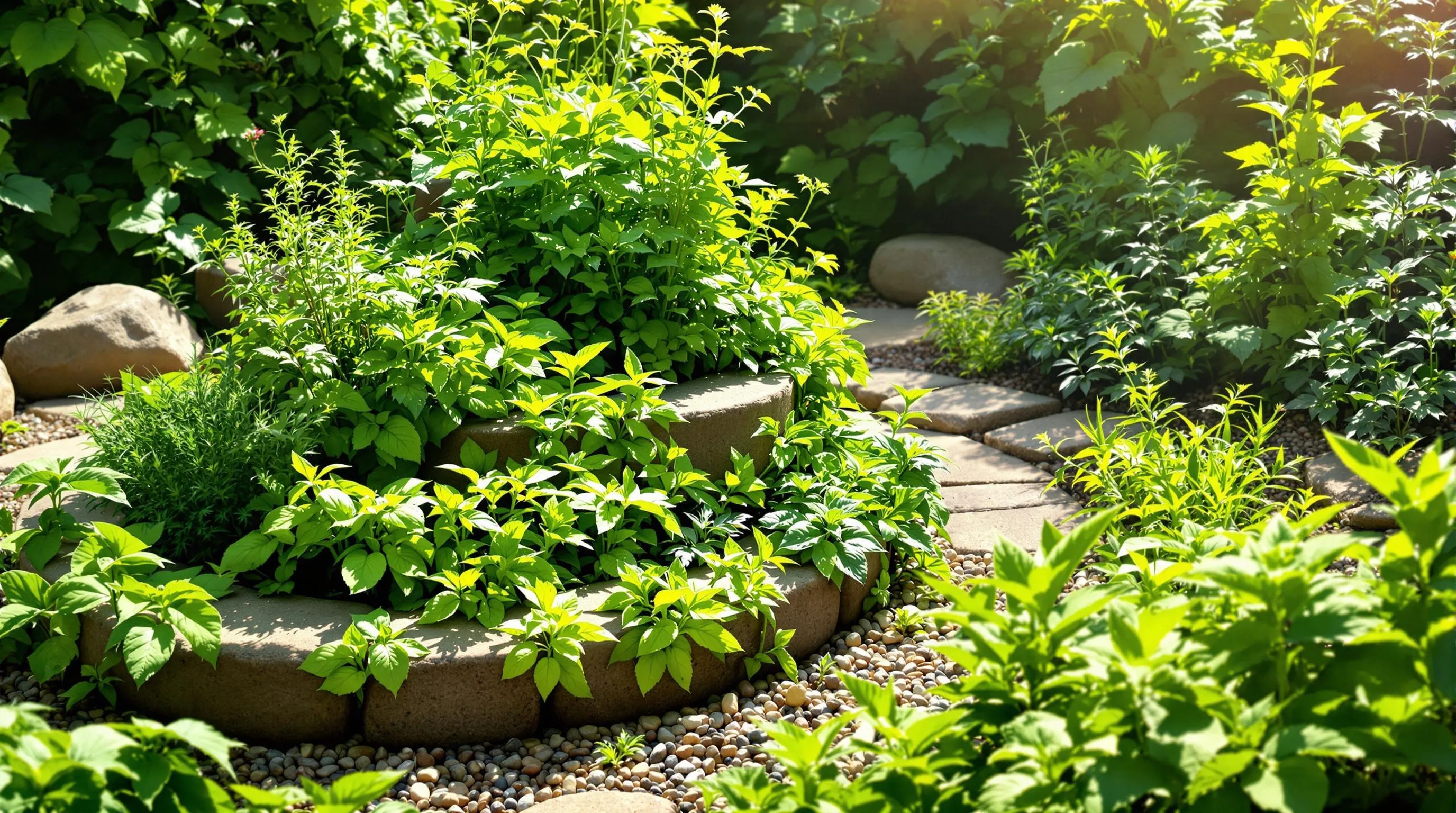
Even the most carefully designed herb spirals can encounter issues. Poor drainage often manifests as waterlogged soil and yellowing plants—fix this by adding more drainage material like gravel at the spiral’s base and adjusting your watering schedule. If you notice uneven growth patterns, assess sunlight exposure and reposition sun-loving herbs to brighter spots while moving shade-preferring varieties to protected areas. Pest problems can be addressed naturally by introducing beneficial insects, companion planting with pest-repellent varieties like marigolds, or applying organic neem oil answers. For structural instability, reinforce your spiral’s foundation by resetting loose stones and adding stabilizing material between layers. When soil quality deteriorates, rejuvenate it with fresh compost additions in spring and fall. Addressing dry spots might require installing a simple drip irrigation system focused on problem areas. By regularly monitoring your spiral and implementing these targeted answers, you’ll maintain a thriving herb garden that continues providing fresh harvests throughout the growing season.
Conclusion: Creating Your Own Herb Spiral Sanctuary
Your herb spiral journey offers endless possibilities for creativity and sustainability. From selecting the perfect location to choosing complementary herbs and adding eco-friendly elements you’ll create more than just a garden—you’ll build a thriving network right in your yard.
Whether you opt for traditional fieldstone rustic charm or modern brick patterns your herb spiral will serve as both a functional growing space and an eye-catching focal point. The beauty of this permaculture design lies in its adaptability to any space from sprawling backyards to cozy balconies.
Start small experiment with designs and watch as your herb spiral becomes a sanctuary for beneficial insects pollinators and of course a convenient source of fresh herbs just steps from your kitchen. Your sustainable herb spiral awaits!

